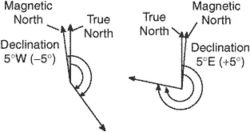declination
declination
(dek-lă-nay -shŏn) (dec) Symbol: δ. A coordinate used with right ascension in the equatorial coordinate system. The declination of a celestial body, etc., is its angular distance (from 0° to 90°) north (counted positive) or south (counted negative) of the celestial equator. It is measured along the hour circle passing through the body.Declination
(religion, spiritualism, and occult)The solar system lies more or less in one geometric plane, which is why astrological charts can be drawn in two dimensions. If the celestial equator (which is the terrestrial equator extended out into space, and projected against the background of the stars) is used as a point of reference, it is found that, at any given time, most celestial bodies do not lie exactly in the same plane, but, rather, are located somewhat north or south of the celestial equator. The angular distance (distance expressed in degrees and minutes) of these bodies north or south of the celestial equator is their declination. Because some astrologers regard planets at the same declination as being in aspect with one another, planets’ declinations are often recorded in ephemerides.
declination
[‚dek·lə′nā·shən]declination

ii. The angular distance of a celestial body from the celestial equator along the hour circle of the body. Measured in degrees, or radians, through 90°, and named north or south, depending on whether the body is north or south of the celestial equator. Declination on the celestial sphere is analogous to the latitude of the earth. The value of declination cannot exceed 90°.
